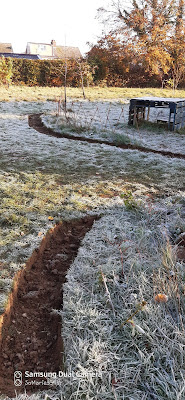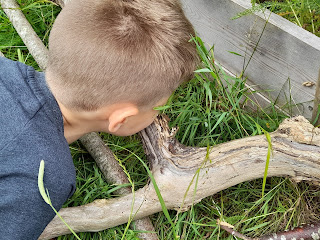Planting a Forest
We are planting our trees mostly to create more hedging, but some will stand alone entities - or will be when they grow longer than than half a metre tall!
the trees came via the Woodland Trust and we have 420 to plant. It's a plan to extend the Forest school area for the future, and to give every child the opportunity to plant their very own tree. This process is going to take up a lot of this term! Each pupil will receive information about the species of their tree and make a label for it. It will also be mapped so we know where it is. For those children in EYFS right now the next 6 years ought to allow a lot of visible growth to monitor. Hopefully for those currently in Year 6 the coming of Spring and Summer 2021 will also show a lot of change. The prep work, digging spaces to plant the new hedges, is a slow process! However it will speed up the actual planting quite a lot. So far, the children seem excited at the mere thought of planting a tree, only a few have actually started putting them in soil. Meanwhile as fast as the FSL digs a 'trench' the children pile in to save the worms and remove the mud blocks to build huts and Worm Hills with!
The prep work, digging spaces to plant the new hedges, is a slow process! However it will speed up the actual planting quite a lot. So far, the children seem excited at the mere thought of planting a tree, only a few have actually started putting them in soil. Meanwhile as fast as the FSL digs a 'trench' the children pile in to save the worms and remove the mud blocks to build huts and Worm Hills with!
So much research points towards the benefits of humans connecting with nature. Children thrive outdoors and Outdoors thrives when we appreciate it. When we see ecological pyramids, or food chains, or any ordering of life on Earth the human is usually at the top. It never points out the damage people may do to the layers below them in that pyramid, or how that makes the human placement precarious, nor how far up the food chain we are if we're unarmed! The point is we are part of nature. We rely on it. We master some of it, we are subject to some of it, we live alongside most of it and we cannot survive without it! Strengthening that connection empowers us, and, as with all lessons in life, starting early in childhood makes the knowledge and skills and understanding for living IN a world of nature easier to learn about and connect to.
Currently organisations like Nature Premium and the Nature Friendly Schools initiative (which is backed by Government) recognise the difference nature makes to school life. Of course places like the Woodland Trust also do a lot to promote and help schools become more in tune with nature. Not only their Green Tree Award system, or the free trees/hedges schools can apply for, but they also have specific trees for urban areas. The RSPB also run wildlife challenges which fit nicely into the curriculum and make Outdoor Learning an easy thing to slide into planning!
If you haven't discovered this little gem yet it's worth a look! Not only is the animation of the book beautifully done, it's an amazing starter for conversation and it's follow up information make lesson planning easier. The Promise is a great book to read at Basecamp and although it is aimed at rewilding an urban area, it is also a great opportunity with schools that have space or more rural settings to contact those who don't.
The benefits of this nature connection are both physical and mental and therefore also emotional. The biodiversity hypothesis points towards microbes in dirt strengthening the human immune system, and therefore a playground more like the Forest Floor and less like tarmac has shown benefits.
Taking a walk with the idea of looking out for nature no only focuses the mind but this recognition of the amazing everyday around us inspires awe and lifts the mood. An awe inspiring walk doesn't have to be a hike up Snowdon (although it could be!), a walk in the park looking out for how many birds you can hear, how many different colours you can see, which spot gives the best view of what is around you, will still change the way you react to what may be a well trodden path! The charity MIND champion getting outside to: reduce stress (or anger), to give time out and relax you, to improve your self esteem, and your physical health, whether wandering or running!
We may not even think of a week on a beach in the sun as immersed in nature, but few of us dream of 7 days on a sunbed in a small room on the high street! Like it or not, we all look to being outdoors as a way to relax. Even in Winter being outdoors will up your vitamin D levels. The difficulty can be the cold - exposing skin to it midwinter doesn't sound appealing! A brisk walk that makes you unzip your jacket a bit can also mean rolling up your sleeves, and the inner forearm absorbs UV light well! 10-20 mins of cooling down this way will still help keep Vitamin D levels up!Hopefully Chartham's children will be breaking a sweat digging holes for some very small and very precious trees! 'Owning' one ought to give them a vested interest in the school grounds and the outside world as a whole, and as the trees are not going anywhere, I hope most of the children get to see them grow and develop as they themselves do.
There will be some aspect of ongoing care that they can take part in, and as more wildlife moves into the areas we create, then they will witness the diversity around them and their positive impact on the environment, alongside the negative effect we need to be conscious of and limit.Making poppies outside at basecamp for Remembrance the children were all aware of us using yarn and sticks and twine and ivy, rather than glue and plastic, and all age groups commented. "There's no glue because there isn't glue in the forest.", "We don't want plastic outside it's not good for wildlife. "We're only using natural stuff." Understanding is the first step to caring and respecting.
More forests and woods.
We need to protect what we have.
400+ baby twig-like-trees cannot replace an ancient established woodland.
Planting a forest isn't the same as raising a forest but it is a beginning, and an opportunity to raise foresters too!
It is an investment in the future.












Comments
Post a Comment